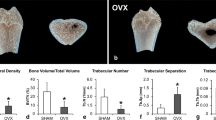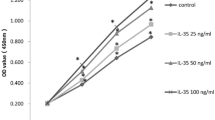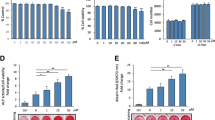Abstract
Summary
The effects of oleuropein on the processes of osteoblastogenesis and adipogenesis in mesenchymal stem cells (MSCs) from human bone marrow have been studied. We report that oleuropein, a polyphenol abundant in olive tree products, reduces the expression of peroxisome proliferator-activated receptor gamma (PPARγ), inhibits adipocyte differentiation, and enhances differentiation into osteoblast.
Introduction
Age-related bone loss is associated with osteoblast insufficiency during continuous bone remodeling. It has been suggested that the formation of osteoblasts in bone marrow is closely associated with adipogenesis, and age-related changes in this relationship could be responsible for the progressive adiposity of bone marrow which occurs with osteoporosis. In addition, the consumption of oleuropein, a major polyphenol in olive leaves and olive oil, has been associated with a reduction in bone loss.
Methods
We have analyzed the effects of oleuropein—at concentrations between 10−6 and 10−4 M—on the processes of osteoblastogenesis and adipogenesis in MSCs from human bone marrow.
Results
The results show an increase in osteoblast differentiation and a decrease in adipocyte differentiation when there is oleuropein in the culture media. The gene expression of osteoblastogenesis markers, RUNXII, osterix, collagen type I, osteocalcin, or alkaline phosphatase (ALP), was higher in osteoblast-induced oleuropein-treated cells. Also, the ALP activity and extracellular matrix mineralization were higher when oleuropein was present in the media. Oleuropein in MSCs induced adipocytes to produce a decrease in the expression of the genes involved in adipogenesis, the PPARγ, lipoprotein lipase, or fatty acid-binding protein 4, and minor fat accumulation.
Conclusion
Our data suggest that oleuropein, highly abundant in olive tree products included in the traditional Mediterranean diet, could prevent age-related bone loss and osteoporosis.





Similar content being viewed by others
References
Seeman E, Delmas PD (2006) Bone quality—the material and structural basis of bone strength and fragility. N Engl J Med 354:2250–2261
Raisz LG (2005) Pathogenesis of osteoporosis: concepts, conflicts, and prospects. J Clin Invest 115:3318–3325
Hartsock RJ, Smith EB, Petty CS (1965) Normal variations with aging of the amount of hematopoietic tissue in bone marrow from the anterior iliac crest. A study made from 177 cases of sudden death examined by necropsy. Am J Clin Pathol 43:326–331
Meunier P, Aaron J, Edouard C, Vignon G (1971) Osteoporosis and the replacement of cell populations of the marrow by adipose tissue. A quantitative study of 84 iliac bone biopsies. Clin Orthop Relat Res 80:147–154
Pei L, Tontonoz P (2004) Fat’s loss bone’s gain. J Clin Invest 113:2
Gimble JM, Zvonic S, Floyd ZE, Kassem M, Nuttall ME (2006) Playing with bone and fat. J Cell Biochem 98:251–266
Duque G (2008) Bone and fat connection in aging bone. Curr Opin Rheumatol 20:429–434
Johnell O, Gullberg B, Allander E, Kanis JA (1992) The apparent incidence of hip fracture in Europe: a study of national register sources. MEDOS Study Group. Osteoporos Int 2:298–302
Kanis JA (1993) The incidence of hip fracture in Europe. Osteoporos Int 3(Suppl 1):10–15
Perri E, Raffaelli A, Sindona G (1999) Quantitation of oleuropein in virgin olive oil by ionspray mass spectrometry-selected reaction monitoring. J Agric Food Chem 47:4156–4160
Brenes M, Garcia A, Garcia P, Rios JJ, Garrido A (1999) Phenolic compounds in Spanish olive oils. J Agric Food Chem 47:3535–3540
Vissers MN, Zock PL, Katan MB (2004) Bioavailability and antioxidant effects of olive oil phenols in humans: a review. Eur J Clin Nutr 58:955–965
Puel C, Mardon J, Kati-Coulibaly S, Davicco MJ, Lebecque P, Obled C, Rock E, Horcajada MN, Agalias A, Skaltsounis LA, Coxam V (2007) Black Lucques olives prevented bone loss caused by ovariectomy and talc granulomatosis in rats. Br J Nutr 97:1012–1020
Puel C, Quintin A, Agalias A, Mathey J, Obled C, Mazur A, Davicco MJ, Lebecque P, Skaltsounis AL, Coxam V (2004) Olive oil and its main phenolic micronutrient (oleuropein) prevent inflammation-induced bone loss in the ovariectomised rat. Br J Nutr 92:119–127
Puel C, Mathey J, Agalias A, Kati-Coulibaly S, Mardon J, Obled C, Davicco MJ, Lebecque P, Horcajada MN, Skaltsounis AL, Coxam V (2006) Dose–response study of effect of oleuropein, an olive oil polyphenol, in an ovariectomy/inflammation experimental model of bone loss in the rat. Clin Nutr 25:859–868
Visioli F, Galli C (2002) Biological properties of olive oil phytochemicals. Crit Rev Food Sci Nutr 42:209–221
Casado-Diaz A, Santiago-Mora R, Jimenez R, Caballero-Villarraso J, Herrera C, Torres A, Dorado G, Quesada-Gomez JM (2008) Cryopreserved human bone marrow mononuclear cells as a source of mesenchymal stromal cells: application in osteoporosis research. Cytotherapy 10:460–468
Franceschi RT, Ge C, Xiao G, Roca H, Jiang D (2009) Transcriptional regulation of osteoblasts. Cells Tissues Organs 189:144–152
Hofbauer LC (1999) Osteoprotegerin ligand and osteoprotegerin: novel implications for osteoclast biology and bone metabolism. Eur J Endocrinol 141:195–210
Moerman EJ, Teng K, Lipschitz DA, Lecka-Czernik B (2004) Aging activates adipogenic and suppresses osteogenic programs in mesenchymal marrow stroma/stem cells: the role of PPAR-gamma2 transcription factor and TGF-beta/BMP signaling pathways. Aging Cell 3:379–389
Martin RB, Zissimos SL (1991) Relationships between marrow fat and bone turnover in ovariectomized and intact rats. Bone 12:123–131
Junqueira VB, Barros SB, Chan SS, Rodrigues L, Giavarotti L, Abud RL, Deucher GP (2004) Aging and oxidative stress. Mol Aspects Med 25:5–16
Lavrovsky Y, Chatterjee B, Clark RA, Roy AK (2000) Role of redox-regulated transcription factors in inflammation, aging and age-related diseases. Exp Gerontol 35:521–532
Manolagas SC (2010) From estrogen-centric to aging and oxidative stress: a revised perspective of the pathogenesis of osteoporosis. Endocr Rev (in press)
Basu S, Michaelsson K, Olofsson H, Johansson S, Melhus H (2001) Association between oxidative stress and bone mineral density. Biochem Biophys Res Commun 288:275–279
Yousefzadeh G, Larijani B, Mohammadirad A, Heshmat R, Dehghan G, Rahimi R, Abdollahi M (2006) Determination of oxidative stress status and concentration of TGF-beta 1 in the blood and saliva of osteoporotic subjects. Ann N Y Acad Sci 1091:142–150
Forman BM, Tontonoz P, Chen J, Brun RP, Spiegelman BM, Evans RM (1995) 15-Deoxy-delta 12, 14-prostaglandin J2 is a ligand for the adipocyte determination factor PPAR gamma. Cell 83:803–812
Klein RF, Allard J, Avnur Z, Nikolcheva T, Rotstein D, Carlos AS, Shea M, Waters RV, Belknap JK, Peltz G, Orwoll ES (2004) Regulation of bone mass in mice by the lipoxygenase gene Alox15. Science 303:229–232
Kliewer SA, Sundseth SS, Jones SA, Brown PJ, Wisely GB, Koble CS, Devchand P, Wahli W, Willson TM, Lenhard JM, Lehmann JM (1997) Fatty acids and eicosanoids regulate gene expression through direct interactions with peroxisome proliferator-activated receptors alpha and gamma. Proc Natl Acad Sci U S A 94:4318–4323
Schopfer FJ, Lin Y, Baker PR, Cui T, Garcia-Barrio M, Zhang J, Chen K, Chen YE, Freeman BA (2005) Nitrolinoleic acid: an endogenous peroxisome proliferator-activated receptor gamma ligand. Proc Natl Acad Sci U S A 102:2340–2345
Lecka-Czernik B, Moerman EJ, Grant DF, Lehmann JM, Manolagas SC, Jilka RL (2002) Divergent effects of selective peroxisome proliferator-activated receptor-gamma 2 ligands on adipocyte versus osteoblast differentiation. Endocrinology 143:2376–2384
Habauzit V, Horcajada M-N (2008) Phenolic phytochemicals and bone. Phytochem Rev 7:21
Alarcon de la Lastra C, Barranco MD, Motilva V, Herrerias JM (2001) Mediterranean diet and health: biological importance of olive oil. Curr Pharm Des 7:933–950
Masella R, Giovannini C, Vari R, Di Benedetto R, Coni E, Volpe R, Fraone N, Bucci A (2001) Effects of dietary virgin olive oil phenols on low density lipoprotein oxidation in hyperlipidemic patients. Lipids 36:1195–1202
Kasdallah-Grissa A, Nakbi A, Koubaa N, El-Fazaa S, Gharbi N, Kamoun A, Hammami M (2008) Dietary virgin olive oil protects against lipid peroxidation and improves antioxidant status in the liver of rats chronically exposed to ethanol. Nutr Res 28:472–479
Cicero AF, Nascetti S, Lopez-Sabater MC, Elosua R, Salonen JT, Nyyssonen K, Poulsen HE, Zunft HJ, Kiesewetter H, de la Torre K, Covas MI, Kaikkonen J, Mursu J, Koenbick C, Baumler H, Gaddi AV (2008) Changes in LDL fatty acid composition as a response to olive oil treatment are inversely related to lipid oxidative damage: the EUROLIVE study. J Am Coll Nutr 27:314–320
Puel C, Mardon J, Agalias A, Davicco MJ, Lebecque P, Mazur A, Horcajada MN, Skaltsounis AL, Coxam V (2008) Major phenolic compounds in olive oil modulate bone loss in an ovariectomy/inflammation experimental model. J Agric Food Chem 56:9417–9422
Conflict of interest
None.
Author information
Authors and Affiliations
Corresponding author
Electronic supplementary material
Below is the link to the electronic supplementary material.
Fig. S1
The oleuropein toxicity on MSC-h have been analyzed with an apoptosis test. There are no significant differences between the control (oleuropein untreated cells) and the culture treated with oleuropein. ***p < 0.001 vs untreated MSCs (GIF 14 kb)
Fig. S2
Elocution crystal violet: the cellular density does not show difference when the oleuropein is or is not in the media (GIF 35 kb)
Rights and permissions
About this article
Cite this article
Santiago-Mora, R., Casado-Díaz, A., De Castro, M.D. et al. Oleuropein enhances osteoblastogenesis and inhibits adipogenesis: the effect on differentiation in stem cells derived from bone marrow. Osteoporos Int 22, 675–684 (2011). https://doi.org/10.1007/s00198-010-1270-x
Received:
Accepted:
Published:
Issue Date:
DOI: https://doi.org/10.1007/s00198-010-1270-x




